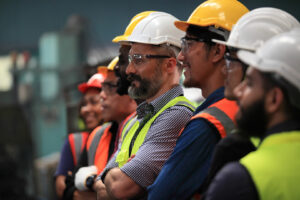
Despite a slower December in 2021 than anticipated due to staff shortages and isolation challenges, it wasn’t all bad news for the construction industry in the UK. The number of construction firms reporting supplier delays dropped from 47% in November to 34% in December so hopefully, the worst of the raw material scarcities have now passed – but challenges will remain across the sector as there will be inevitable skills, driver and transport shortages into 2022.
So how can your business prepare for this? How can you build resilience and success in 2022 and what other new trends should you be aware of?
We believe that there will be 5 key issues and trends that will affect construction supply chains in 2022.
Legislation
Being agile and responsive to government policy requests feels like the theme over the past couple of years, but in 2022 there are two larger pieces of legislation arriving in the form of the Building Safety Bill and the implementation of the Environment Act 2021 which was passed in November.
The building Safety Bill is largely aimed at residential developments and “sets out the framework to improve compliance, with tougher penalties for those who break the rules and mandates developers to belong to a New Homes Ombudsman scheme.” So the stakes are high to ensure compliance.
Net Zero
We could have included this in either our Legislation or Social Value Policy trends but the push for net-zero and environmental/climate standards will become even more of a focus this year and warrants specific attention.
Since October 2021, all businesses applying for government contracts worth more than £5 million per year are required by law to commit to achieving net-zero emissions by 2050.
The new rules set out in Public Policy Note 06/21, mean organisations will need to create a carbon reduction plan detailing where their emissions come from and what environmental management measures they have in place. The requirements are currently only applicable to government contracts, but they may be included in the Common Assessment Standard in 2022. So it’d be good to get ahead of the curve and start gathering the data you need now – and working with a supplier base that supports your net-zero targets.
Social Value Policy
While some companies may have already started considering the Social Value Policy implications within their business, we think in 2022 there will be a stronger focus on the framework as measures and definitions become more defined.
As such, we believe supply chain managers in the construction industry will be gathering more diverse datasets from their supply base over the coming 12 months. The big question is how is this data collected, stored, shared and accessed to drive evidence-led decisions and help you win more business where Social Value Policy counts.
Digitalisation
Traditionally, construction has not always been the fastest sector to adopt technological developments but in the last couple of years, rapid changes in working practice have necessitated an acceleration on this front.
Now this investment has been made, leaders across the sector are looking for ways to enhance the impact of digital platforms on their processes, productivity and profitability.
As the adoption of new technology has increased and some competence and capability challenges overcome, we believe the trend of digitalisation will continue apace as the people within the organisation mature. We’ll see new challenges arise, as platforms that have been implemented for speed or adapted from legacy systems like ERP’s will start to become technological hindrances and distractions to productivity – forcing a rethink.
Shortages
Even though the massive supply chain disruptions of the latter half of 2021 seem to be easing, there is still considerable attention and discussion over the state of both supplies of raw materials and logistics coming into 2022.
With this in mind – forward-thinking supply chain teams are adapting their risk management profiles and re-assessing their supply base through a new lens. Many are starting to use master data and supplier relationship management tools to do this digitally as the digitalisation trend above permeates productivity and risk management processes.
Summary
2022 is set to be a year of commercial recovery, digital maturity and legislative adaptations in the construction industry. We’re excited to see how our large customer base of construction companies address the changes in the sector.
We see many of the recurring challenges highlighted above being vastly reduced in their impact through robust data management practices. Alongside embedding collaborative digital working and using cloud platforms that address process inefficiency and reduce the busy work – the demands on your workload will become easier to manage despite new metrics, measures and objectives.
If you’d like to join some of the leading construction companies in the UK managing their supply chains for their companies or projects in SourceDogg, contact us for a personalised demo today.





